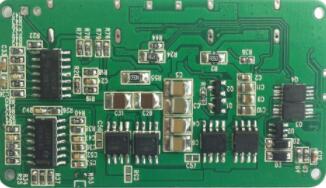Common high-frequency board surface treatment processes include: hot air leveling, organic coating (OSP), electroless nickel/immersion gold, immersion silver, immersion tin, etc.
High-frequency board surface treatment hot air leveling
Hot air leveling is also known as hot air solder leveling. It is a process of coating molten tin-lead solder on the PCB high-frequency board and leveling (flattening) with heated compressed air to form a layer that is resistant to copper oxidation and can provide Good solderability coating. During hot air leveling, the solder and copper form a copper-tin metal compound at the junction, and its thickness is about 1 to 2 mils.
High frequency board surface treatment immersion tin
Since all current solders are based on tin, the tin layer can match any type of solder. From this point of view, the immersion tin process has great development prospects. However, tin whiskers are prone to appear in the previous PCBs after the immersion tin process, and the tin whiskers and tin migration during the soldering process will cause reliability problems, thus restricting the use of the immersion tin process. Later, organic additives were added to the tin immersion solution to make the tin layer structure in a granular structure, which overcomes the previous problems and also has good thermal stability and solderability. Others indicate that there are fewer applications of treatment processes, among which electroplating of nickel and gold and electroless palladium are more commonly used.

High frequency board surface treatment OSP anti-oxidation
OSP anti-oxidation is different from other surface treatment processes in that it acts as a barrier layer between copper and air; simply put, OSP anti-oxidation is to chemically grow an organic film on the clean bare copper surface . This layer of film has anti-oxidation, thermal shock resistance, and moisture resistance to protect the copper surface from rusting (oxidation or sulfidation, etc.) in a normal environment; at the same time, it must be easily assisted in the subsequent welding high temperature The flux is quickly removed to facilitate soldering.
High-frequency plate surface treatment chemical nickel/immersion gold (also known as chemical gold)
Electroless nickel/immersion gold actually wraps a thick layer of nickel-gold alloy with good electrical properties on the copper surface and can protect the PCB for a long time. Unlike OSP, which is only used as an anti-rust barrier layer, it can be useful and achieve good electrical performance during long-term use of PCB high-frequency boards. In addition, it also has environmental tolerance that other surface treatment processes do not have.
High frequency board surface treatment immersion silver
The immersion silver process is between OSP and electroless nickel/immersion gold, and the process is simple and fast. Immersion silver is not a thick armor for PCB. Even if exposed to heat, humidity and pollution, it can still provide good electrical performance and maintain good solderability, but it will lose its luster. Because there is no nickel under the silver layer, immersion silver does not have the good physical strength of electroless nickel/immersion gold. Immersion silver is a displacement reaction, it is almost submicron pure silver coating. Sometimes the immersion silver process also contains some organic matter, mainly to prevent silver corrosion and eliminate the problem of silver migration. It is generally difficult to measure this thin layer of organic matter. Analysis shows that the weight of the organism is less than 1%.
High frequency board surface treatment chemical palladium plating
The process of electroless palladium plating is similar to that of electroless nickel plating. The main process is to reduce the palladium ion to palladium on the catalyzed surface through a reducing agent. The new palladium can be called a catalyst to promote the reaction, so a palladium plating layer of any thickness can be obtained. The advantages of electroless palladium plating are good welding reliability, thermal stability, and flatness.
High frequency boar d surface treatment electroplating nickel gold (electroplating gold)
Electroplating nickel gold is the originator of PCB surface treatment process. It has appeared since PCB appeared, and other processes have slowly evolved. Nickel-gold electroplating is to electroplate a layer of nickel on the surface of the PCB and then electroplate a layer of gold. Nickel plating is mainly to prevent the diffusion between gold and copper. There are two types of electroplated nickel gold: soft gold plating (pure gold, gold indicates that it does not look bright) and hard gold plating (the surface is smooth and hard, wear-resistant, contains cobalt and other elements, and the surface looks brighter). Soft gold is mainly used for gold wire during chip packaging; hard gold is mainly used for electrical interconnection (such as gold fingers) in non-welded areas. Under normal circumstances, welding will cause the electroplated gold to become brittle, which will shorten the service life, so avoid welding on electroplated gold; while electroless nickel/immersion gold is very thin and consistent, so brittleness rarely occurs .